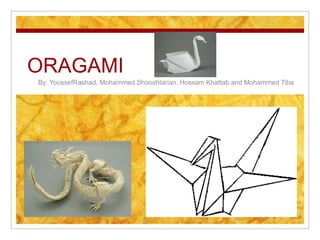
Orgami
- 1. ORAGAMI By: YoussefRashad, Mohammed Shooshtarian, Hossam Khattab and Mohammed Tiba
- 3. Origami (pronounced or-i-GA-me) is the Japanese art of paper-folding. "Ori" is the Japanese word for folding and "Gami" is the Japanese word for paper. That is how origami got its name. However, origami did not start in Japan. It began in China in the first or second century and then spread to Japan sometime during the sixth century.
- 5. Not only were the Japanese folding paper, but the Moors, who were from Africa, brought paper folding with them to Spain when they invaded that country in the eighth century. The Moors used paper folding to create geometric figures because their religion prohibited them from creating animal forms. From Spain it spread to South America. As trade routes were developed, the art of origami was introduced to Europe and later the United States.
- 6. Master paper folders can be found in many places around the world. Akira Yoshizawaof Japan is one of these. He is considered the "father of modern origami" because of his creative paper folding. He also developed a set of symbols and terms that are used worldwide in the written instructions of origami. The interest in origami continues to increase today. Just as the ancient Japanese found useful purposes for their origami models, so do we today. Origami will also be a part of our future as we look toward the millennium. The origami crane has become a global peace symbol.
- 7. At first, there was very little paper available so only the rich could afford to do paper folding. The Japanese found useful purposes for their origami. For example, the Samurai (sa-MURE-ay) would exchange gifts with a form known as a noshi(NO-shee). This was a paper folded with a strip of dried fish or meat. It was considered a good luck token. Also, the Shinto Noblemen would celebrate weddings by wrapping glasses of sake or rice wine in butterfly forms that had been folded to represent the bride and groom.
- 8. Japanese Tradition/Culture The folded paper crane is a well-known origami figure. Probably everybody in Japan has made at least one. According to Japanese tradition, one way to pray for good health is by folding a thousand origami cranes. Sometimes if a person is very sick, his or her friends will work together to fold a thousand cranes and string them on thread into long chains, which they take to the sick friend. Chains of a thousand paper cranes ease pain and sadness and bring hope to people who see them. This was also used in world war II, a famous lady called Sudako tried making 1000 paper cranes and nothing had happened to her and she had died from the radiation of the atomic bomb in Hiroshima, Japan
- 9. How Origami Relates to the environemtn Origami relates to the environment in a number of ways: Firstly, orgami shapes are very often related to the natural environment It seems that within origmi, humans are seeing animals and plants around them They then try to recreate what they are seeing with paper, and in this way it show a bond with the environment
- 10. FACTS The largest number of origami cranes was created as part of the 50th anniversary of the dropping of the atom bomb on Hiroshima. A total of 250,000 paper cranes were folded and displayed in a large memorial in the city. Each had a person's name on it and a short, peaceful message. A paper crane is a symbol for world peace. During the first and second century oragmi was used in China as a school activity. Later on it spread to Japan and is now known as JappanesseOrigmai. Origami is traditionally made out of a square piece of origami paper, which can be white, colorful or boasting unique designs. However, origami can also be made from coarse cloth, foil and even food. Many artists around the world specialize in these different types of materials, including international chefs and even fashion designers.
- 11. Bibliography MLA "Origami Trivia - Exploring Origami - Virtual Culture - Kids Web Japan - Web Japan." Web Japan : Top Page. Web. 16 Mar. 2011. http://web-japan.org/kidsweb/virtual/origami2/exploring04.html. "Origami." Wikipedia, the Free Encyclopedia. Web. 16 Mar. 2011. <http://en.wikipedia.org/wiki/Origami>. "What Is Origami?" WiseGEEK: Clear Answers for Common Questions. Web. 16 Mar. 2011. <http://www.wisegeek.com/what-is-origami.htm>. http://library.thinkquest.org/5402/history.html "Origami for Kids." Coloring Pages, Kids Crafts and Printable Activities For Kids. Web. 16 Mar. 2011. <http://www.activityvillage.co.uk/origami_for_kids.htm>.
